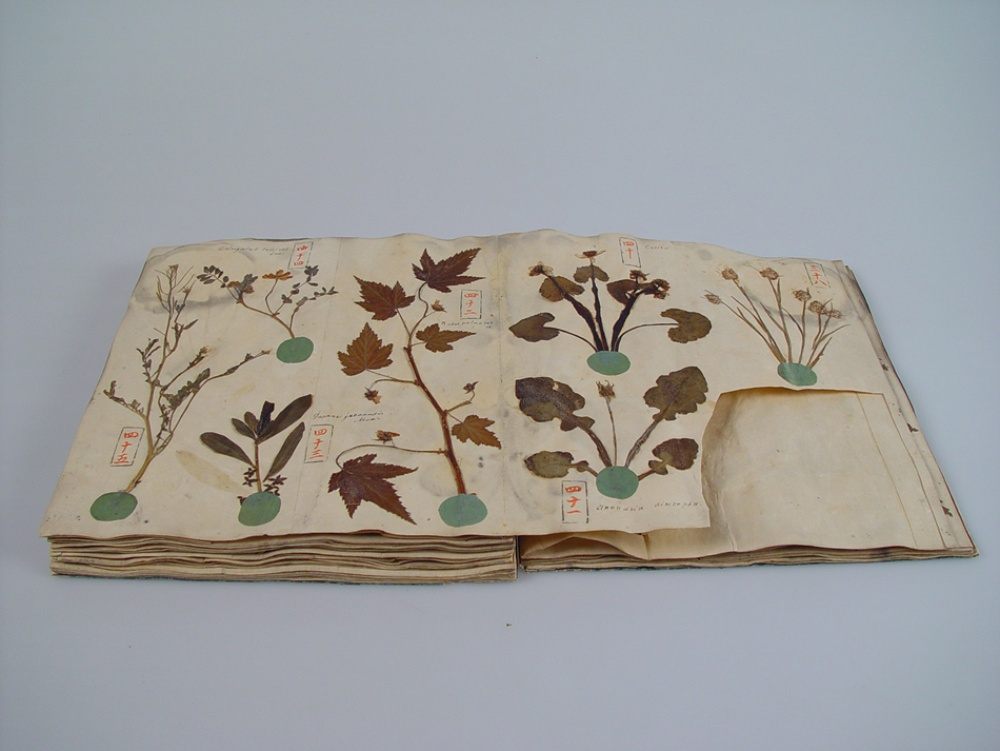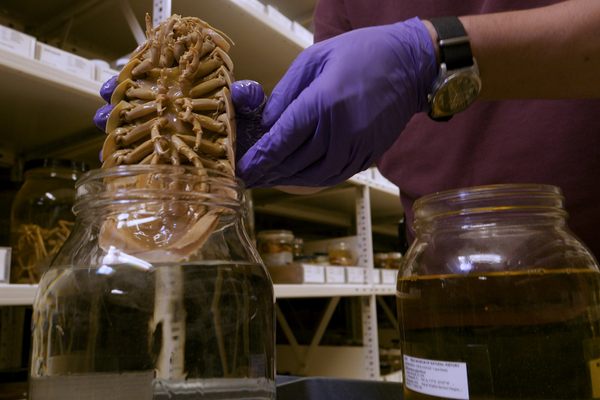It’s Hard to Be a Natural History Museum in the 21st Century
As belts tighten, rich collections of plant and animal specimens face relegation, dissolution, or worse.

The space where the University of Louisiana at Monroe housed its natural history collection was embarrassing. About five years ago, the biology department had to move its extensive collection of Louisiana plants and fish, one of the largest and most complete in the state, from a dedicated space in a campus building to an old print shop under an old stadium. It was cramped and gloomy, without nice working space for researchers. It was only supposed to be there for a year, before returning to an academic building.
But then one year turned into two, which became four, until this spring, when the school told the collection’s managers that they needed to find a new home for it, so the stadium could be renovated for the track team. They were given 48 hours to find a space on campus. After that, they would have a few short months to find some other institution to take over the collection, permanently. After hearing this news, the curator of the museum’s herbarium, Thomas Sasek, wrote on Facebook: “We were told that if the collections are not donated to other institutions, the collections will be destroyed at the end of July.”
Locally, there had already been protests when the collection was exiled under the stadium. Now, the science community across the country—and the world—raised a much louder outcry over the possible destruction of close to 500,000 plant samples and six million fish specimens. In the wake of this anger, the school reversed itself, and said it had never intended to destroy the collection. But its ultimate position was firm: The collection needs a new home, and that is not likely to be on the Monroe campus. Another institution would need to adopt it.

While the fate of Monroe’s collection played out more publicly than most, this story is a depressingly common one. Back in 2009, Sasek started coordinating 12 Louisiana plant collections (also called herbaria) in an effort to digitize their collections. Since then, three or four of the smaller collections have closed, two or three curators are nearing retirement and are unlikely to be replaced, and Tulane’s herbarium—“a famous, wonderful collection,” says Sasek—is being consolidated with the one at Louisiana State University. Across North America, more than 100 herbaria have closed in the past two decades. In the United Kingdom, at least 64 museums have closed since 2010, and though not all of those are natural history museums, “we think that natural history is getting cut disproportionately,” says Jack Ashby, a trustee of the Natural Sciences Collections Association.
These collections are more than just samples under glass for field trips and sketchbook-toting artists—they’re critical research tools. Any expertly curated and collected set of specimens is essentially a snapshot of a certain place and time, of which animals and plants lived where and when. “The whole reason we have collections is so people can go back to them for more information,” says Barbara Thiers, president-elect of the Society for the Preservation of Natural History Collections and director of the Steere Herbarium at the New York Botanical Garden. “They’re like the chemist’s notebook. If you have questions or disagree with their conclusions, you go back to the original item those findings were based on.” Scientists use these collections to discover unknown species hiding in their drawers, understand how biodiversity is changing with the climate, and document the impacts humans have on local environments. Individual specimens can be valuable for their uniqueness, too, but a collection like the one at University of Louisiana at Monroe tells a story in its entirety.
Today, it’s easy to overlook this value and to consider these collections dusty relics of a time before digital databases, but, as Thiers says, “I’ve never seen a dusty natural history collection.” The people who manage these compendiums are now fighting to demonstrate this relevance in the 21st century and figuring out what it will take for them to survive.

For all their value, natural history collections can be a headache to maintain and manage. “Everything is organic, and everything is dangerous,” says Ashby. Living bugs love to eat dead bugs, or birds or mammals or plants, and pests can eat through drawers of specimens before anyone even notices a problem. Today, collection managers use integrated pest management strategies, but in the past the more common option was poisons, including arsenic, which linger in the collections, a hazard for anyone handling old specimens. There’s also the problem of specimens preserved of jars of ethanol, which evaporates through imperfect seals and needs to be topped off at regular intervals. Plus, “if you’ve got thousands of specimens in jars, you’ve got hundreds of liters of extraordinarily flammable liquid,” says Ashby. “You can’t just lock them in a cupboard and forget about them.”
In addition, even the management of natural history collections requires specialized knowledge about the laws and safety requirements that govern the movement of specimens. To share a sample with a researcher or another collection can require working through a byzantine series of state- and country-specific laws regarding plants, animals, or human remains. And when these processes go wrong, they can go very wrong: Just this month, Australian officials incinerated a specimen used to originally describe a plant species because of a biosecurity paperwork mixup. And again, ethanol carries the risk of explosions. Any specimen preserved in it has to be packed specially so that it stays moist but isn’t floating in a jar of flammable liquid.
All of this is expensive and space-intensive, which makes it hard for budget-strapped institutions to justify keeping natural history collections, especially since they’re perceived to have less monetary value than art collections. As budgets have shrunk, so has staffing, which exacerbates the challenges of care and management. At University of Louisiana at Monroe, for example, Sasek became the herbarium’s curator after the person hired to do that job left and there was no money to hire a replacement. Sasek, a biology professor, stepped in to the role of curator as, essentially, a volunteer. Even at the largest institutions, collections staff have had to become evangelists and engage the public—both to advocate for the collections’ survival and because there are fewer staff to take on those responsibilities.

One way that natural history curators have demonstrated the relevance of their collections is to digitize their specimens, which makes the collection more widely available for research and accessible even to the general public. Sasek started digitizing the Monroe herbarium specimens because “it’s a huge collection but we’re out in the middle of nowhere,” he says. By collaborating with a consortium of institutions across the Southeast, he can combine his data with others’ to map the biodiversity across the region—and showcase the collective value of the drawers and drawers of dried leaves.
“When the data are unlocked in digital form, they have a new relevance, but it’s basically like creating a second collection,” says Thiers. “As we see changes in the biota, due to climate change and development, there’s a huge, huge need for continued field surveys and building collections. It’s constantly a question of having to do more with less. Digitizing, education, and outreach—all that with the same or fewer resources than we had before.”

Even getting rid of a natural history collection can be resource-consuming. “You can’t just pour hundreds of liters of formaldehyde down the drain,” says Ashby. Disposal of anything in a natural history collection was once considered entirely taboo, but in recent years there’s been a move toward judicious pruning. “It would be dishonest to say that every specimen in every museum is of world-class research value,” Ashby says. At the collection where he works, he adds, “We have hundreds of rabbit legs, which presumably is a remnant of some dissection anatomy class from the 1960s. It’s unlikely that they’re going to be of huge research use to the world.”
In the United Kingdom, accredited museums that want to move on from a collection must follow a hierarchy of possible new homes—public museums, private museums, research institutions, schools, and so forth—before they can dispose of anything. It’s inconvenient, but it’s meant to avoid the fate that some collections have met over the years. “In the ’80s and ’90s and earlier, particularly in university museums, collections were literally being skipped. Thrown in the dumpster,” says Ashby. “I’ve heard of dodos going in skips. It’s just because some one person has made the decision that this isn’t valuable.”
The organizations that Ashby and Thiers work with try to save endangered collections when they hear about them, helping to find new homes for endangered collections. But there are limits to this solution.* In the three decades she’s worked at the New York Botanical Garden, Thiers says, they’ve taken between 10 and 15 orphaned collections. “But we are running out of room,” she says, “and most other herbaria are running out of room, too.”
Sasek and his colleagues have been working to find a new home for their collection. Right now, it looks like Louisiana State University, which has recently built a new herbarium and absorbed Tulane’s, could be a likely destination. Even if the collection is not destroyed, though, it might have to be split up. Since the collection covers the whole state, one institution might be interested in the parts that are locally relevant, but not the whole. It could simply be a question of space. There may not be one place with the capacity to take the whole collection. If it is split up, it will require even more management and coordination to preserve its value. But the decision to split up the collection, like the decision to put in storage in the first place, might become a self-fulfilling prophecy. When these collections aren’t valued as a whole, they lose any value at all.
*Correction: This paragraph originally included information about a herbarium at the Liverpool Museum that was incorrect and has been cut out.


























Follow us on Twitter to get the latest on the world's hidden wonders.
Like us on Facebook to get the latest on the world's hidden wonders.
Follow us on Twitter Like us on Facebook